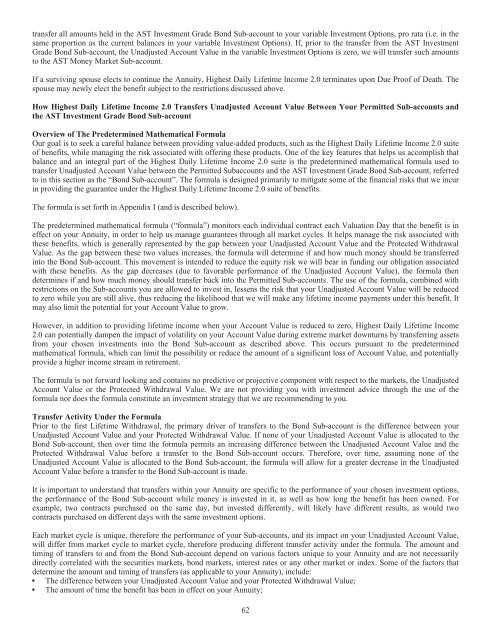Prudential Premier Retirement Variable Annuities
Prudential Premier Retirement Variable Annuities
Prudential Premier Retirement Variable Annuities
You also want an ePaper? Increase the reach of your titles
YUMPU automatically turns print PDFs into web optimized ePapers that Google loves.
transfer all amounts held in the AST Investment Grade Bond Sub-account to your variable Investment Options, pro rata (i.e. in the<br />
same proportion as the current balances in your variable Investment Options). If, prior to the transfer from the AST Investment<br />
Grade Bond Sub-account, the Unadjusted Account Value in the variable Investment Options is zero, we will transfer such amounts<br />
to the AST Money Market Sub-account.<br />
If a surviving spouse elects to continue the Annuity, Highest Daily Lifetime Income 2.0 terminates upon Due Proof of Death. The<br />
spouse may newly elect the benefit subject to the restrictions discussed above.<br />
How Highest Daily Lifetime Income 2.0 Transfers Unadjusted Account Value Between Your Permitted Sub-accounts and<br />
the AST Investment Grade Bond Sub-account<br />
Overview of The Predetermined Mathematical Formula<br />
Our goal is to seek a careful balance between providing value-added products, such as the Highest Daily Lifetime Income 2.0 suite<br />
of benefits, while managing the risk associated with offering these products. One of the key features that helps us accomplish that<br />
balance and an integral part of the Highest Daily Lifetime Income 2.0 suite is the predetermined mathematical formula used to<br />
transfer Unadjusted Account Value between the Permitted Subaccounts and the AST Investment Grade Bond Sub-account, referred<br />
to in this section as the “Bond Sub-account”. The formula is designed primarily to mitigate some of the financial risks that we incur<br />
in providing the guarantee under the Highest Daily Lifetime Income 2.0 suite of benefits.<br />
The formula is set forth in Appendix I (and is described below).<br />
The predetermined mathematical formula (“formula”) monitors each individual contract each Valuation Day that the benefit is in<br />
effect on your Annuity, in order to help us manage guarantees through all market cycles. It helps manage the risk associated with<br />
these benefits, which is generally represented by the gap between your Unadjusted Account Value and the Protected Withdrawal<br />
Value. As the gap between these two values increases, the formula will determine if and how much money should be transferred<br />
into the Bond Sub-account. This movement is intended to reduce the equity risk we will bear in funding our obligation associated<br />
with these benefits. As the gap decreases (due to favorable performance of the Unadjusted Account Value), the formula then<br />
determines if and how much money should transfer back into the Permitted Sub-accounts. The use of the formula, combined with<br />
restrictions on the Sub-accounts you are allowed to invest in, lessens the risk that your Unadjusted Account Value will be reduced<br />
to zero while you are still alive, thus reducing the likelihood that we will make any lifetime income payments under this benefit. It<br />
may also limit the potential for your Account Value to grow.<br />
However, in addition to providing lifetime income when your Account Value is reduced to zero, Highest Daily Lifetime Income<br />
2.0 can potentially dampen the impact of volatility on your Account Value during extreme market downturns by transferring assets<br />
from your chosen investments into the Bond Sub-account as described above. This occurs pursuant to the predetermined<br />
mathematical formula, which can limit the possibility or reduce the amount of a significant loss of Account Value, and potentially<br />
provide a higher income stream in retirement.<br />
The formula is not forward looking and contains no predictive or projective component with respect to the markets, the Unadjusted<br />
Account Value or the Protected Withdrawal Value. We are not providing you with investment advice through the use of the<br />
formula nor does the formula constitute an investment strategy that we are recommending to you.<br />
Transfer Activity Under the Formula<br />
Prior to the first Lifetime Withdrawal, the primary driver of transfers to the Bond Sub-account is the difference between your<br />
Unadjusted Account Value and your Protected Withdrawal Value. If none of your Unadjusted Account Value is allocated to the<br />
Bond Sub-account, then over time the formula permits an increasing difference between the Unadjusted Account Value and the<br />
Protected Withdrawal Value before a transfer to the Bond Sub-account occurs. Therefore, over time, assuming none of the<br />
Unadjusted Account Value is allocated to the Bond Sub-account, the formula will allow for a greater decrease in the Unadjusted<br />
Account Value before a transfer to the Bond Sub-account is made.<br />
It is important to understand that transfers within your Annuity are specific to the performance of your chosen investment options,<br />
the performance of the Bond Sub-account while money is invested in it, as well as how long the benefit has been owned. For<br />
example, two contracts purchased on the same day, but invested differently, will likely have different results, as would two<br />
contracts purchased on different days with the same investment options.<br />
Each market cycle is unique, therefore the performance of your Sub-accounts, and its impact on your Unadjusted Account Value,<br />
will differ from market cycle to market cycle, therefore producing different transfer activity under the formula. The amount and<br />
timing of transfers to and from the Bond Sub-account depend on various factors unique to your Annuity and are not necessarily<br />
directly correlated with the securities markets, bond markets, interest rates or any other market or index. Some of the factors that<br />
determine the amount and timing of transfers (as applicable to your Annuity), include:<br />
▪ The difference between your Unadjusted Account Value and your Protected Withdrawal Value;<br />
▪ The amount of time the benefit has been in effect on your Annuity;<br />
62

















